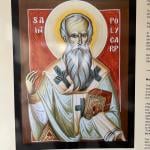Craig Carter, one of the leading interpreters of Yoder’s work, says I got Yoder wrong in my post yesterday. He writes on his blog. He says that I “don’t understand what Yoder meant by the Constantinian Shift. Your mistake is actually a common one. This is not for Yoder an historical thesis as in: ‘Constantine caused the Church to become unfaithful by co-0pting it.’
“Constantinianism for Yoder is an eschatological heresy which tries to reach forward and pull the future kingdom of God back into the present sphere of history with no regard for the necessity of a still-future Second Coming of the Messiah, thus turning the Kingdom into a human political project. Yoder names the shift after Constantine to give it a handy label, but he is talking about a lack of faithfulness in the Church caused by bad eschatology, rather than trying to give an historical explanation of where this bad eschatology and resulting unfaithfulness came from.”
Carter has much deeper knowledge of Yoder than I, but I’m not convinced, and I think Carter has missed my criticism. I recognize that Yoder is not offering the historical thesis that Constantine caused the church to become unfaithful. Still, it’s clear to me that Yoder is “trying to give an historical explanation” of the shift in ecclesiology and eschatology that he describes as “Constantinian.”
In the chapter of Priestly Kingdom where he gives a systematic summary of the rise of Constantinianism, he says that Constantine the man is not the issue, but rather stands as “the symbol of an epochal shift.” This shift is not just from pacificism to justifying war, but at the “deeper” level of ecclesiology and eschatology.
Ecclesiologically, “the composition of the church changed” from a persecuted minority to “everyone.” Before, it took some courage to become a Christian; after Constantine, “it would take exceptional conviction not to be counted as a Christian.” He begins the next paragraph: “What this means, of course, is that the meaning of the word ‘Christian’ has changed.’” Yoder isn’t here merely noting that the meaning changed, but trying to explain the historical dynamics of that change – that is, the shift form the church as a persecuted minority to the church as dominant majority. This created pressure to formulate a doctrine of an ecclesia invisibilis .
In fact, he offers this clearly causal statement: The “moral, emotional, and even intellectual” life of the church were “changed by the reversal of the sociologial and political pressures ” (my emphasis). Yoder is making the kind of claim that Carter denies, it seems: He is offering “an historical explanation” of the shift, not attributing it to the single man Constantine but to the new social and political status of the church.
Yoder equally offers a historical explanation of the shift in eschatology. This is partly a change in the doctrine of Providence. Prior to Constantine, Providence was viewed as Christ’s hidden governance of the powers, but after Constantine “God’s governance of history had become empirically evident in the person of the Christian ruler of the world.” This was followed by a change in millennial belief, in which the “millennium was soon pulled back from the future (whether distant or imminent) into the present. All that God can possibly have in store for a future victory is more of what has already been won.”
The historical causation here is not as overt as in Yoder’s explanation of the change in ecclesiology. Yet, the change in the doctrine of Providence depends on having a visible governor of history as the head of the Roman empire. If there had never been a Christian emperor, it doesn’t seem that the change in the view of Providence that Yoder describes could have taken place, or at least it would have taken a different direction.
The ethical shift is also clearly tied, causally, to the shift in the church’s status: “Ethics had to change .” Why? “Because one must aim one’s behavior at strengthening the regime, and because the ruler himself must have very soon some approbation and perhaps some guidance as he does things the earlier church would have disapproved of.” That seems to link the change of ethics with the fact of a professing Christian as emperor.
The distinctive lifestyle of early Christians had to be adjusted and “sweepingly redefined.” Why? Because “many who are ‘Christian’ [in the new sense] have not themselves chosen to follow Christ.” Mission has to be redefined. Why? Among other things, because “beyond the limits of empire [mission] had become identical with the expansion of Rome’s sway.” Doesn’t such a redefinition of mission assume a Christianized empire?
German culture and Christianity get fused because of a prior identification of empire and Christianity: “Once ‘Christendom’ means Empire, non-empire is a new challenge. The era of Charlemagne demonstrates the option of annexation and fusion.” This leads not so much to syncretism but to “an overlaying of two cultures.”
I could go on, but I think I’ve shown sufficiently that Yoder does draw causal connections between shifts in the legal status of the church and the move from minority to dominant majority – symbolized by Constantine – and shifts in eschatology, ecclesiology, and mission. Yoder’s analysis of Constantinianism is a historical claim as well as a theological one. (Of course, it would be for Yoder; he insists, rightly, that history and theology don’t occupy separate realms of investigation. He believes in incarnation.)
Now, that is the thesis I challenged in my earlier post. My point is this: Let me grant for the sake of argument that there is a massive shift in ecclesiology and eschatology beginning in the second and third centuries and becoming more fixed and permanent in the fourth. Yoder explains that shift, explicitly at some points and implicitly at others, as the result of the “reversal of sociological and political pressures.” But then he goes on to say that the theological shifts began before the “sociological and political pressures” reversed. That’s self-contradictory. If the sociological factors that emerge in the fourth century are the explanation, then the shift that they explain cannot happen in the third century.
In other words, before the church became legal, before it was liberated from persecution, before “the church was everybody,” the changes in ecclesiology and eschatology were already emerging. Put in reverse, these changes started happening while the “sociological and political pressures” were still arrayed in sharp opposition to Christianity. And that means that, if there was a shift in eschatology and ecclesiology, some other explanation has to be found.
That leaves a number of possibilities. It might be that sociological and political pressures other than the ones Yoder identifies account for the shift. Elizabeth Digeser’s work offers some hints about what those pressures might have been. It might be that the shifts were internal to the church, the result not of outside social pressures. It might be that the shift is not as dramatic as Yoder suggests. I’m sure there are lots of other options.
One conclusion to draw from this is to call into question Yoder’s choice of Constantine as the “symbol” of the shift he describes. If it started earli
er, and if other factors account for the shift, why still call it a “Constantinian” shift?
The other conclusion is theological. If there was in fact a dramatic shift, and if it can’t be accounted for by the factors that Yoder identifies, then perhaps political recognition and success is not the most fundamental danger to the church. Perhaps, as Gerald Schlabach has argued, faithfulness poses its own temptations.











